2007 VOLKSWAGEN GOLF brakes
[x] Cancel search: brakesPage 237 of 444

Booklet 3.1 Controls and Equipment
Fig . 6 5 holder s in the center console
66 down in th e dir ection of th e arrow.
To close the cupholder, lift the cove r up.
WARNING
Improper use of the be verage holders can
caus e injury .
Do not place hot drinks in the cup holders.
During a normal or sudden maneuver, s udd en
brakin g or in an accident , th e hot liquid can b e
s p ill ed and ca use burns!
Make certain that the bottles or other ject s cannot fall into tl1e driver 's footw ell whil e the vehicle is moving . The bottles or items can fall into the footwell and interfere with ating the ped als. In the event of a sudden
braking maneuve r, you would not be ab le to
apply the brakes, depres s the clutch or
(con tinued)
Neve r put hot drinks or liquid s in the era ge holder. Hot liquid s can spill when the
ve hicl e is moving as well as during brakin g or other sudden maneuver s.
Never put contai ners witl1 hot liquid s in
th e cup hold ers.
Neve r put heavy cups /b everages or ot her
h eavy things in the cup holders. Heavy objects
ca n fly through the passe nger compartment in a cra sh and cause serio us injury.
Make sure d1at no one is in the way when closing the cover of the storage compartment.
Hot liquid s ca n spill in a crash, during hard
Page 260 of 444
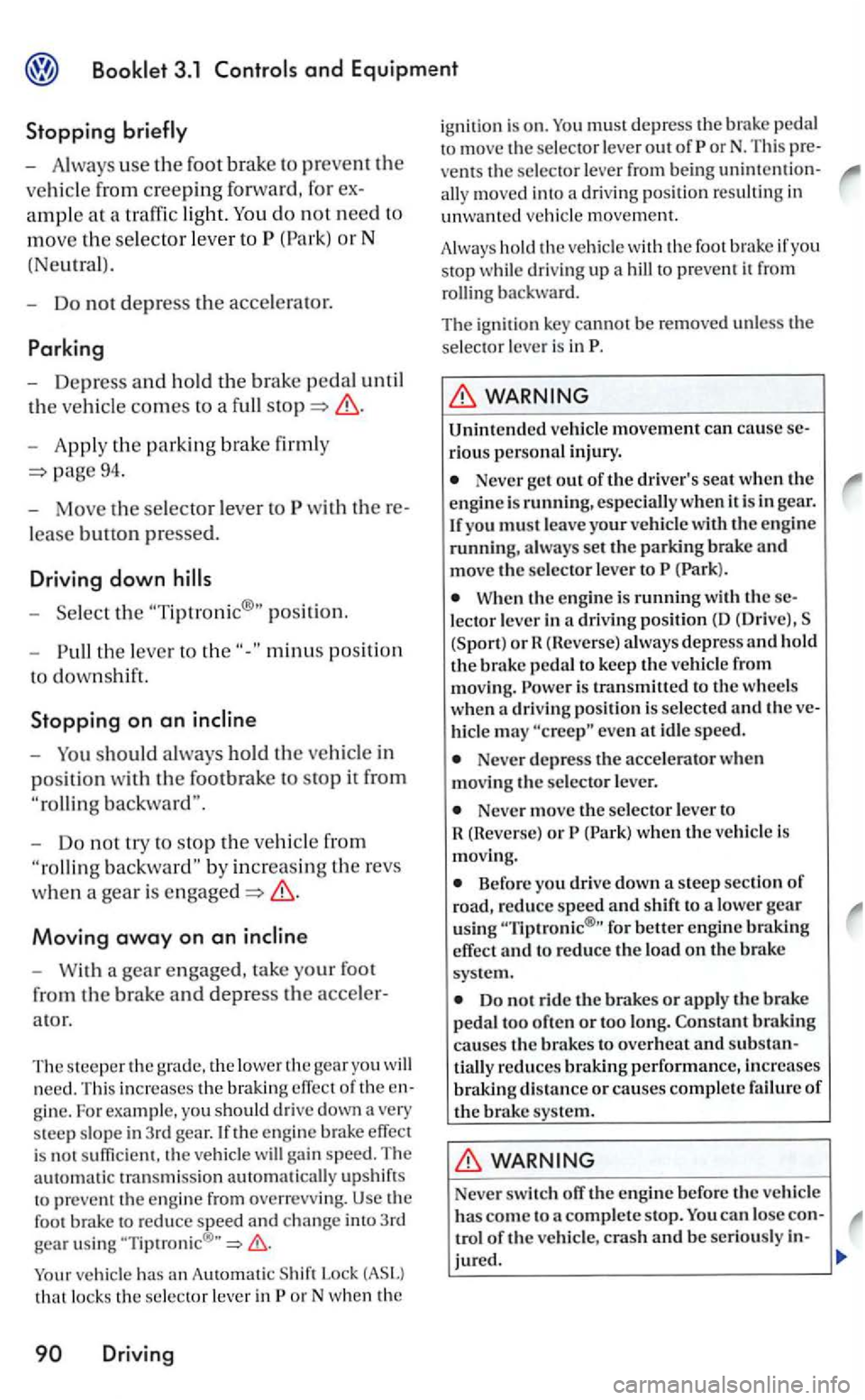
and Equipment
Stopping
-Alw ays use the foot brake to prevent the
vehicle from creeping forward , for
do not need to
move the selector leve r to (Park) or N
(Ne
utra l).
- Do not depress the accele rator.
Parking
- Depress and hold the brake pedal until
the vehicl e comes to a
- App ly the parking brake firmly
94.
- Mo ve th e
selector lever with
lease butto n pressed.
Driving dow n
-the position.
-
the lever to
-
- Do not try to stop the veh icle from
by increa sing the revs
w hen a
gear is
Moving a way on an
- W ith a gear engaged, tak e your foo t
f r o m
the brake and depress the
ator.
Th e stee per the grade, the lower the you will need. This increases the brakin g gine. For examp le, yo u sh ould drive down a very
s teep slop e in 3rd gear.lfthe engine brake is not s uffi cient. the vehicl e will gain spe ed . Th e tran smis sion automati cally up shift s
t o preve nt the engin e from the
foot brake to reduce speed and ch a nge into 3rd gear usin g 'Tiptronic®"
vehicl e has Automatic Sh if t Loc k (ASI.l that locks the selec tor lever in
must depre ss the brake pedal
t o move the selec tor lever out or N. Thi s
ally moved into a driving positi on result ing in unwante d ve hicle movement.
A lw a
ys ho ld th e vehicle with the foot if you
s top while driv in g up a hill to preve nt it fro m
rollin g backwa rd.
T he ig niti on
key ca nnot be remo ved unless the
s el ec tor lever is in
rious personal injury .
Never get out of the dri ver's seat when th e engin e is running, especially when it is in gear. If yo u must leave your vehicl e with the engine running, always set the parking brake and move the se lec tor lever (Pa rk).
When the engine is running with (Dri ve). (Sport) orR (Ileve rse ) a lways depress hold the brake pedal to keep th e ve hicl e from
m ov ing. is trans m i!!ed to the w heels
w hen a driving pos ition is selected even at idle speed.
Never depress th e accelerator when moving the selecto r lever.
Never move the selector lever to
R (Reverse) or whe n the vehicle is
m ov ing.
Before you drive down a steep section of road, reduce speed and shift to a low er gear usin g for better engin e braking effect and to reduce the load on the brake
sys te m.
Do not rid e the brakes or apply the brake pedal too often or too long. Constant braking
causes the brakes to overheat and tially reduces braking performance, increases braking dis tance or causes complete failu re of
the brake sys tem.
Never switch ofT the engine before the vehicle
h as come to complete s top. ca n lose con-trol of the ve hicle , crash and be serious ly in -
jured.
Page 265 of 444
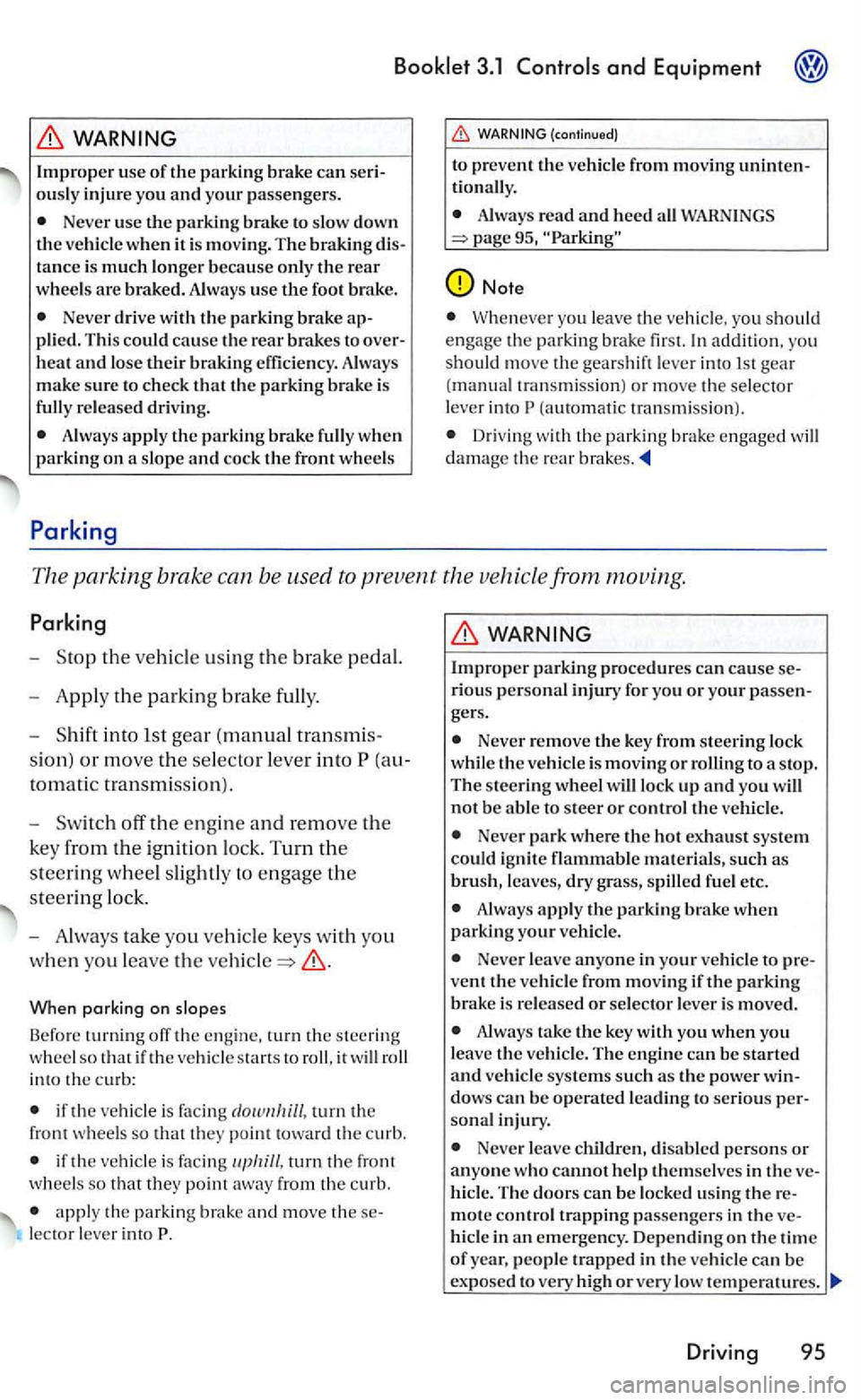
Booklet 3.1 Controls and Equipment
WARNING
Improper use of the parking brake can seri
ousl y injur e yo u and your passenge rs.
Neve r use the parking brake to slo w down
th e ve hicle when it is mov ing. The braking tanc e is much longer because only the rear wheel s are braked. Alwa ys use the foot brake.
Neve r drive with the parking brake plied. This could cause the rear brakes to overheat and los e their braking efficiency. Always
make sure to check that the parkin g is
fully re le a sed dri vin g.
Always apply the parking brake fully when
parking on a slope and cock the front wheels
Parking
(co ntinue d)
to prevent the vehicle from moving
Always read and h ee d WARNINGS
Whe never you leave th e veh icle, you should engage the parkin g
(aut om ati c tra nsm ission) .
Driving w ith the parking brake engaged will damage the rear
The parking bra ke can be used to prevent th.e vehicle from moving.
Parking
-the vehicle using the brake
-Apply th e parkin g brake full y.
-
into lst gear (m anual transmi s
sio n)
or move the se lector lever into
When parking on slo pes
Before turn ing off the engine, turn the steering
w hee l so that if th e vehicle starts roll, it will roll into the curb:
if the vehicle is facing turn the
f ront wheels so that they point toward the curb.
if th e veh ic le is facin g
apply the parkin g brake and m ove theselector leve r into
WARNING
Improper parki ng procedures can cause riou s personal injury for yo u or your passe n
gers.
Neve r remove the key from steering lock
while the ve hicl e is moving or rolling to a s top . The steering wheel will lock up and yo u will not be abl e to steer or contro l th e vehicle.
Neve r park where the hot exhaust system could ig nit e flammable materi als, such as brush, leaves, dry g ra ss, spill ed fue l e tc.
A lwa ys apply the parking brake when parking your vehi cle.
Neve r leave anyone in your vehi cle to vent the ve hicle from movin g if the parking brake is released or selector lever is moved.
Always take th e key with yo u when you leave the vehicle. The engin e ca n b e started and veh icle syste m s s uch as the powe r dows can be operated leadi ng to serious sonal injury.
Neve r leave childre n, disabl ed person s or anyone w ho cannot h elp th e mselves in the hicle. The doors can be locked using th e re-
m ote control trapping passe ngers in the h icle in an emerge ncy . Depending on the tim e of year, peo ple trapped in th e vehicle can be ex po sed to very high or very low temperatures.
Driving 95
Page 278 of 444
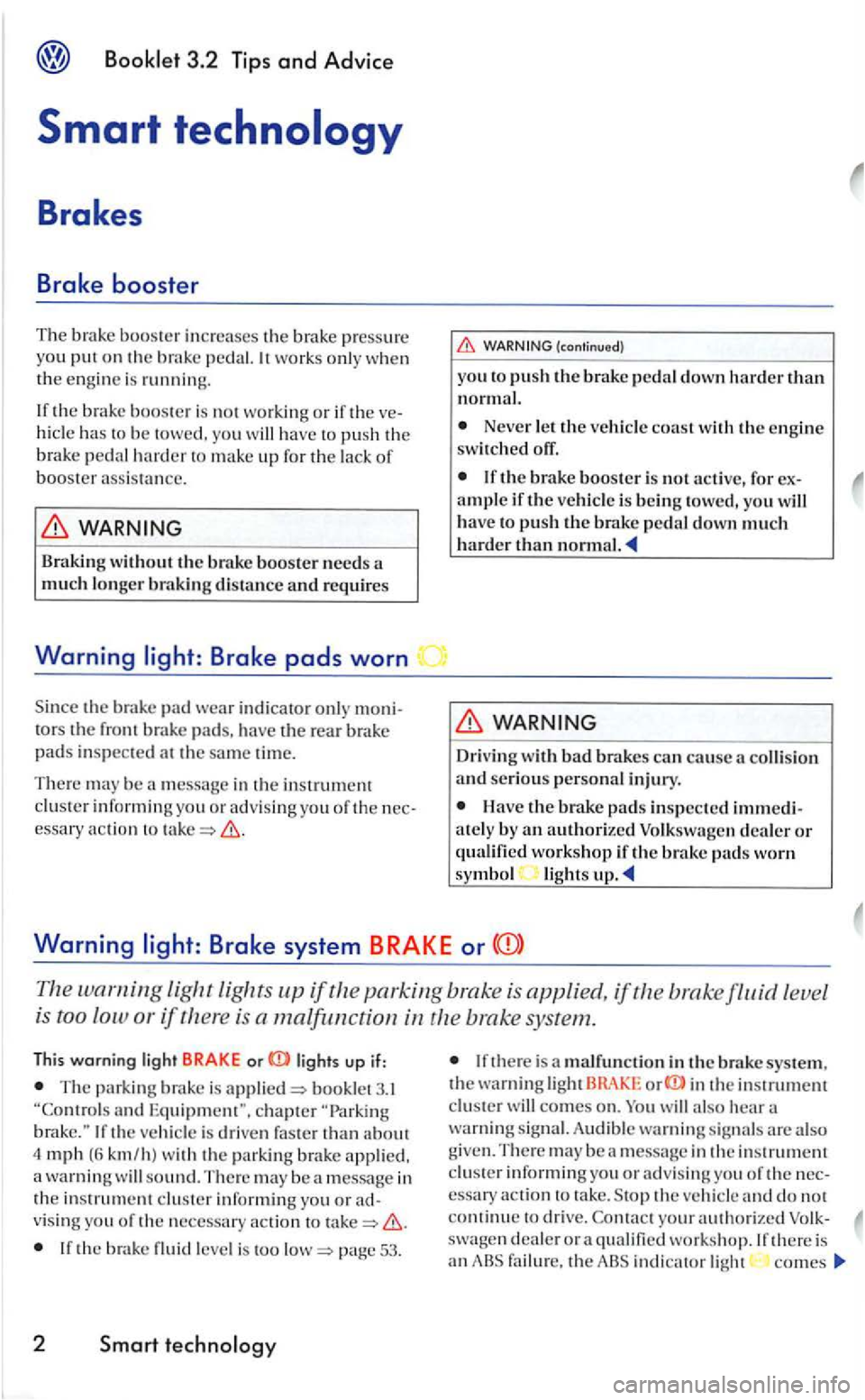
3.2 Tips and Advice
Smart technology
Brakes
Brake booster
The brake booster increases th e brake pre ssure
yo u pu t on th e brak e pedal. works only whe n the engi ne is running.
t h e brake booster is not working or if the hi cle to be tow ed. you will have to push the
b rake pedal harder to mak e up fo r the lack of boos ter assistance.
Braking with out the brake booste r needs much lon ger braki ng distanc e and requires
Warning
the brake pad wear indicator only tors th e front brake pads, the rear brak e pads in spected the sam e time.
There may be m essage in the in strument clu ste r inform ing yo u or advis ing yo u of the essary action to
(co ntinue d)
you to push the brake ped al harder tha n normal.
Never le t the ve hicle coast w ith the engine sw itch ed off.
ample if the vehicle is being towed, you will
have t o pus h the brake pedal much harder than
Driv in g with bad can cause collis ion a nd seriou s persona l injury.
the brake pads in specte d ate ly by an au thorize d Volk swagen d ealer or qualified works ho p if the brake pads worn symbo l l ights
Warning Brake system BRAKE or ((D)
The if parking brake is applied, if th e
the brake system .
This warning light BRAKE or up if:
The park ing brake is booklet and c h a pter "Parkin g th e ve hicle is dri ven faste r than about 4 m ph (6 km/h) with th e parkin g brake a warning sound. There may be message in the ins tru ment clus te r info rmin g yo u or vis ing yo u of the necessa ry action t o
If the brak e flui d leve l is too page 53.
2 Smart
If there is a m alfunction in the brake system , the warni ng in the instrument cluste r will comes on. You also
th e ve hicle and do not continu e to dri ve. Contact yo ur authorized swage n dealer or a qualified work shop. th ere is failur e, the indicator ligh t comes
Page 279 of 444

on. the bra ke sys tem warning symbol or
If a malfunction occurs in the ABS. the warning light light up togethe r the brake o r
39. T he e ngin e com partment of any motor ve hicle is po te ntiall y dangerou s area and can cause serious personal injury.
Dri vin g w ith ba d brakes can cause a c olli sion and serio us person al injury.
does n ot go out, or if it lights up w hen driving the brake fluid level in the reservoir is too lo w or there is a f ault in the brake syste m .lmmedi-
Brake Assist System (BAS)
In an emergency, most drive rs brake in time, but not p in g dista nces that are longer than they have to be!
T he
brake assis t sys te m helps: if yo u p ress the b rake pedal very quick ly , th e brake assist sys te m
regi sters an emergency situation.
can be activated more quickly and ciently, reducing th e brakin g distance while ting you steer at the sam e tim e.
Do no t reduce th e pressure on the brake pedal.
T he bra ke switches off cally as soon as you re lease th e bra ke. The brake assist system work s onl y w hen the engi ne is
nin g.
A lways adjust yo ur speed and driving sty le to road , weather condit io ns.
{continued)
a te ly s to p dri ving a nd ta nce=> page 53.
symbol BRA KE or lights up a t the same ti m e as th eABS warning light the may not be working pro perl y and th e rear w heels could lock up first under
hard braki ng. Rear wheel brake lock-up can cause loss o f vehicl e control. If yo u believe tha t it is safe to do so, go imm ediately a t low speed to the nearest autho rized V olkswagen
dealer o r
w arning light does no t go o ut, or if it comes on w hil e driving, the
your autho rized
V o lkswagen deale r o r qualifi ed wo rkshop as soon as possible.
(continuod)
Neve r let the ex tra safety offered b y the
B rake Ass is t
The Brake Assis t Syst em canno t reduce the
risk o f a n acci dent, fo r example i f yo u drive too fast fo r conditions or if yo u d o not keep your distance from the vehicl e in front of yo u.
S li ppery and we t roads a re dangerous even with the Brake Ass ist Sys te m!
Always re m ember tha t vehi cle alterations
o r m odificati ons can affect the functio n oft h e syste m s. Exa mples of
these alteration s or modifica tions include a different w heel/tire com bination and brake or chassis m odificati on s=> page 32, "Repairs a nd
t echnical m odifica tion s".
the vehicle su sp en sion or u sing unapproved tire I rim combinati on can ch an ge the way the
Smart
Page 280 of 444
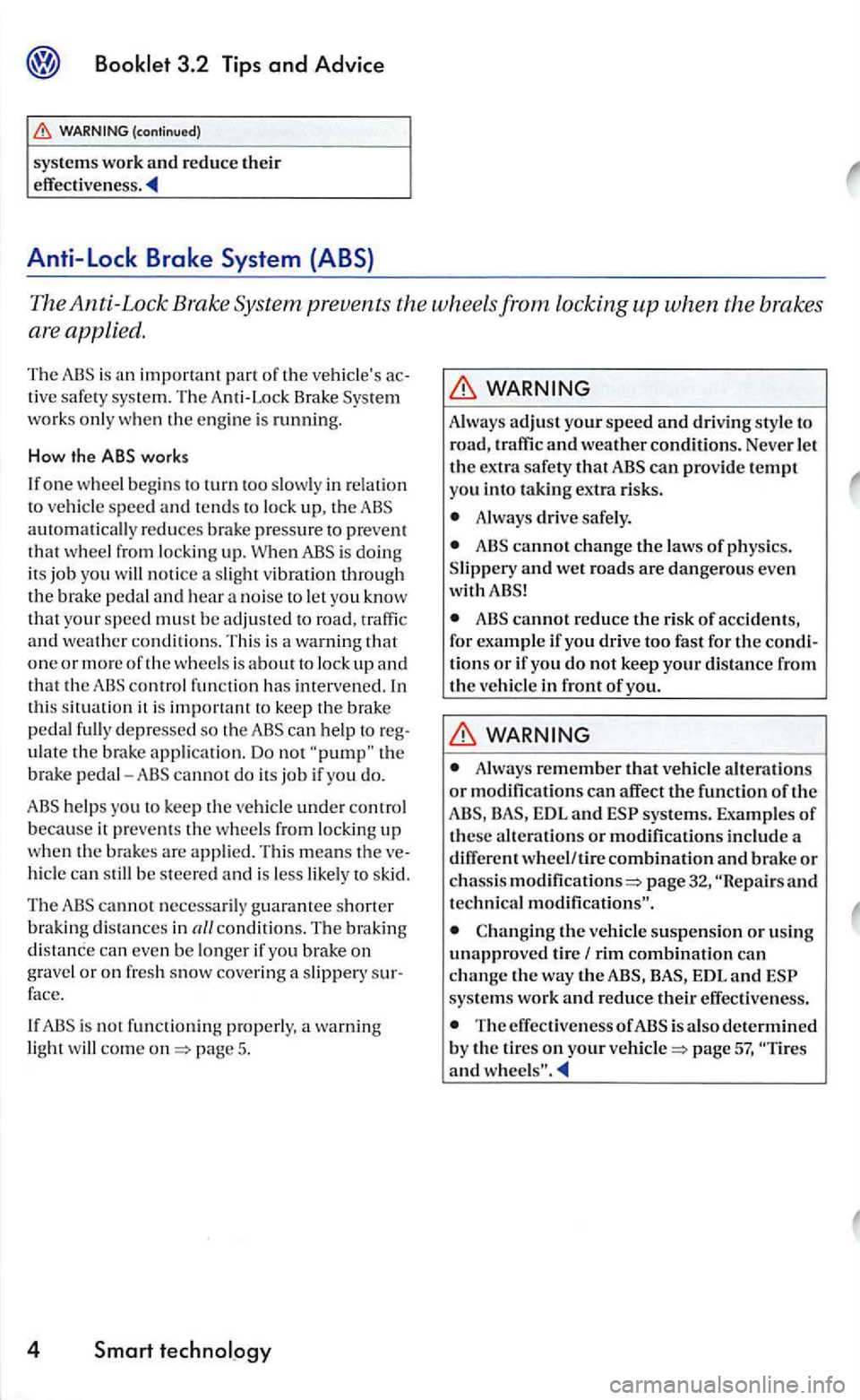
The Anti-Lock Brake System prevents the wheels from locking up when the brakes
are applied.
The is an
works only when the engin e is running.
How the ABS works
I f
one w hee l beg ins to turn too slow ly in relat ion to vehicle spee d and tends to lock up, the automati cally redu ces brak e pressure to pre vent
that w heel from lock ing up. When is doing its job you will notic e a slight vib ration through the brake ped a l a nd hear a noise to le t you know
that your speed must be adjusted to road, traffic and weather co ndition s. Thi s is a warni ng that one or more of th e whee ls is about to lock up and
that th e control function has intervened. In
thi s situati on it is important to keep th e br ake
peda l full y depressed so th e the
b rake ped al-cannot do its job if yo u do .
helps you to keep the vehicle under control
because it pr eve nts th e w hee ls from locking up w hen the brake s are a ppli ed. Thi s m ea ns th e hicle can still be s teered and is less likely to skid.
Th e
cannot necessarily shorte r
braking dis tances in con dition s. The brakin g
di stance ca n eve n be longer if you brake on gravel or on fres h snow c overing a slippery face.
If
i s not fun ctioning properly, a warning
light will co me pag e 5.
4 Smart technol .ogy
Always adjust your speed and driving style to
road, tra ffic and weather co nditions. Never let the ex tr a sa fety that
Alwa ys drive safely.
cannot change the laws of physics.
S lipp ery and wet roads are dangerous even
withABS!
cannot reduc e the risk of accidents,
for example if you drive too fast for the tions or if you do not keep your distance from the veh icle in front of you.
Always remember that vehicle alteration s or modifications can affect the function oft he
page 32, and te chnical modifications".
Changing the vehicle suspension or using unapproved tire
systems work and reduce their effectiveness.
The effec tive ness of is also determined
b y the tir es on your pag e 57 ,
Page 281 of 444

The wa rnin g light ABS does not light up w hen th e ignit io n is switched on .
T he wa rnin g lig ht does not turn off again afte r a few seco nds.
The wa rnin g light light s up whe n the vehicle
i s m ov ing.
Th e ve hicle can still be braked in the normal (except th at the is not active). dealer or a qualifie d works hop as soon as po ssible.
If a fault occurs in theABS. th e
sys te m warning lights BHAKE and/or , th e fective , but there is also possible malfun ction in th e brak e sys te m
Th ere may be a messag e in the in strumem cluster informing yo u or advis ing you of the
Before working in th e e ngin e ment, always read and h ee d all
Driv ing wi th bad brakes can cause a collisio n and seriou s perso nal injury .
If the does not go out, o r i f it up when dri vin g
th e brake fluid leve l in the reservoir is too low or there is a fault in the brake system. ately stop driving and
I f the brak e light s up at the same time warning light ABS or , th e may not be wo rkin g properly and the rear wheels could lo ck up first under hard braking. Hea r wheel brake lo ck-up ca n cause loss of ve hicl e control. If you b elieve that it is to do so, go ately at low sp ee d to the nearest authorized Volkswagen dealer or qualified workshop and have the brake sys te m inspected. Drive slow ly and avoid sudden, hard brake application .
out, or if it comes on while driv ing, the
w ill not have the protectio n provides. Con tact your rized Volkswagen deal e r o r qualified s hop as soon as possible.
Smart technology 5
Page 289 of 444
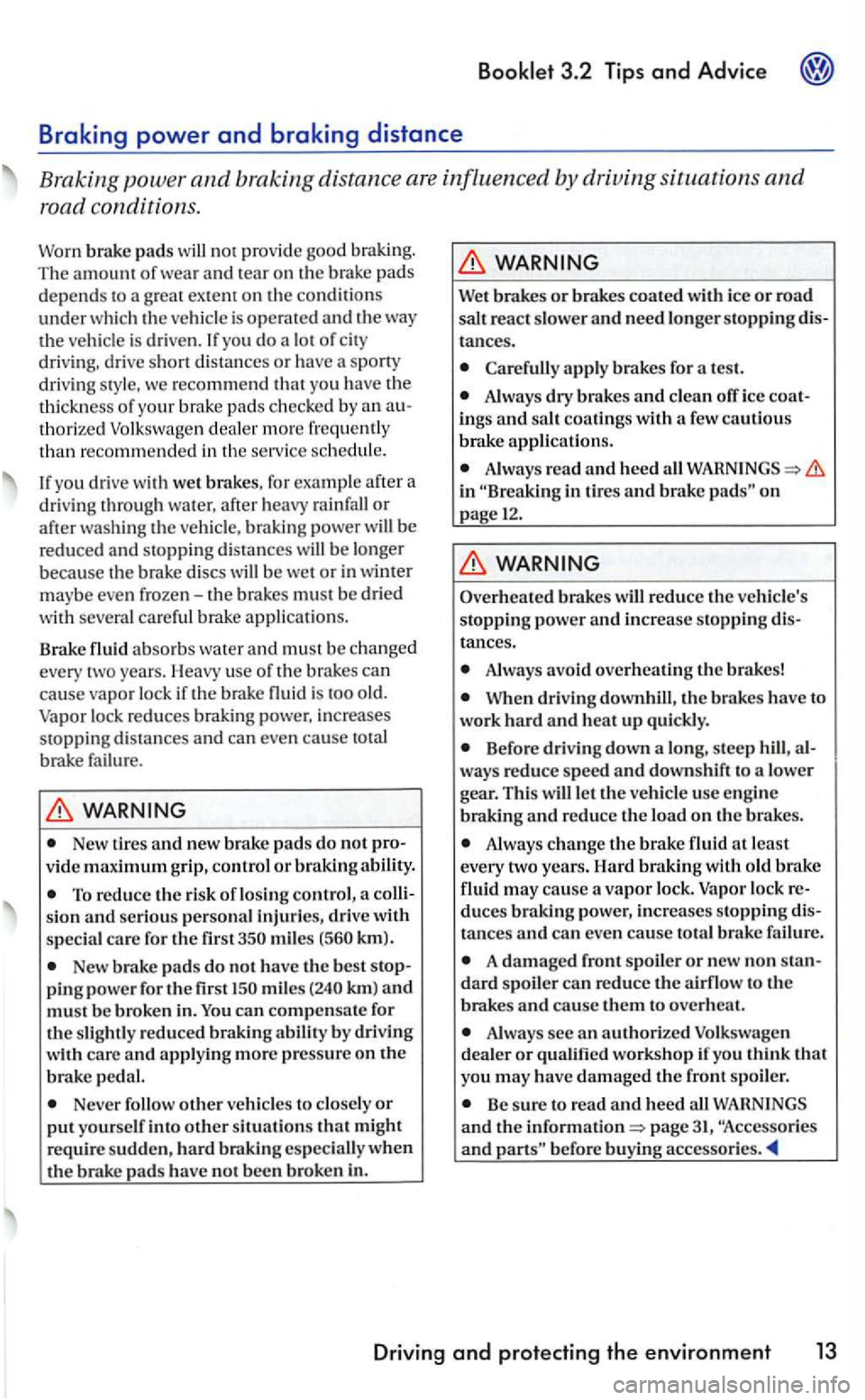
Booklet 3 .2 Tips and Advic e
recommend that you have the
thi ckne ss of your brake pads checked by an au
t horized Vol kswagen dealer mo re fre quent ly
t h an recommende d in the serv ice sched ule.
you drive with wet brakes, for example afte r a
dri ving through water, after heavy rainfall or after washing the ve hicle, braking power be
reduced and s to ppin g distances will be longer
because the brake discs will be we t or in winter mayb e eve n frozen-the brakes must be dried
with several ca re ful brak e applicatio ns.
Brak e fluid absor bs water
and must be changed
every two years. Heavy use of the brakes can cause vapor lock if the brake fluid is too old.
Vapor lock redu ces braking power, increases
stopping distances and ca n even cause total
brake failure.
New tires and new bra ke pads do no t pro
v id e m aximum gri p, control o r b raking abil ity.
To red uce the risk of l osi ng control, a s io n an d se rio us perso nal injuries, drive with
specia l ca re for the first 350 miles (560 km).
New brake pads do not have th e best sto p
ping power for the fir st ISO mile s (240 km ) and
m ust be b roken in. can compensate for the slightly reduced braki ng abil ity by dri ving care and applyin g more pressure on th e
brake pedal.
Never follow oth e r veh icles to close ly or
p u t you rse lf in to other s ituations th at might
requ ire su d den , hard bra king especially when the brake pads have not been broken in.
apply brakes for a test.
Always dry brakes and clea n off icc coat
i ngs an d salt coatings with a few cautious brake applications.
A lways read and heed in in tire s and brake on page 12.
Always avoid overheati ng the brakes!
When driving downhill, t11 e brakes have to
work har d and h eat up quickly.
Before driving down a lo ng, steep hill, al
ways reduce speed and downshift to a lower
gear. This will let the vehicle usc engine
Always ch ange th e brake fluid at l east
every two years. Hard braki ng wi th o ld flui d may cause a va po r lock . Vapor loc k duces powe r, inc reases stoppin g di stan ces and can even cause tota l b rak e failure.
A damaged front spoiler or n ew non standard spoiler can reduce t h e airflow to th e
brakes and cause them to ove rh eat.
Always see an authorized Volkswag en
dealer or qualified workshop
Be sure to re ad and heed all and th e page
Driving and protecting the environm ent 13